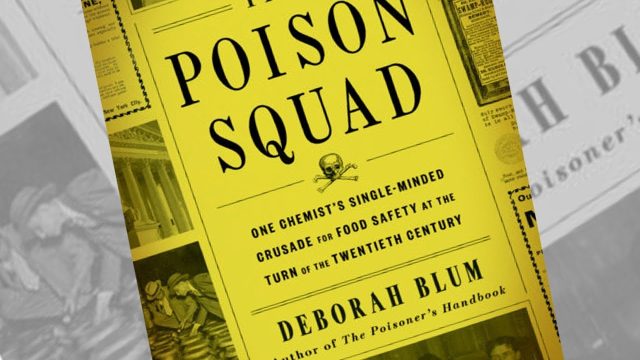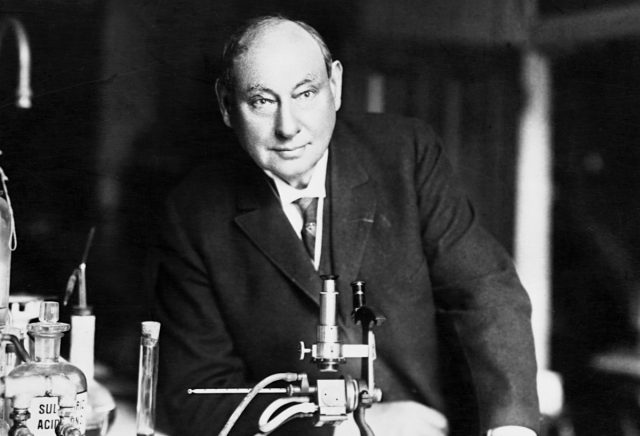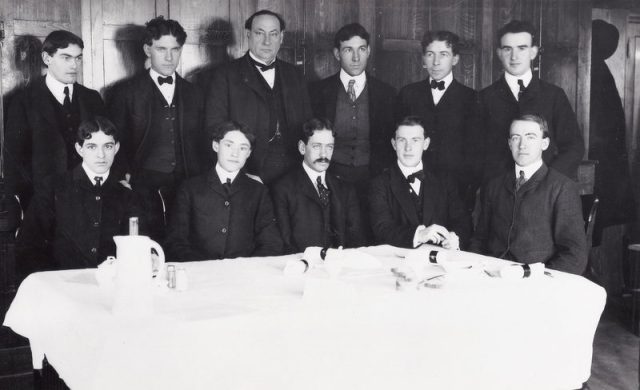As you gathered to celebrate the Thanksgiving holiday last week—avoiding romaine lettuce potentially contaminated by E. coli—we hope you remembered to give thanks for the landmark 1906 Pure Food and Drug Act. Signed into law by President Theodore Roosevelt, it was the first regulatory law to enforce food safety standards in America, along with the Federal Meat Inspection Act.
It was known as "Dr. Wiley's Law," in honor of Dr. Harvey Washington Wiley, who served as chief chemist of the US agriculture department at the time and proved a tireless crusader for consumer protection. He even recruited several of his young male employees to ingest common chemical food additives to test their safety, dubbed the "Poison Squad." The story of his decades-long fight is the subject of Pulitzer Prize-winning journalist Deborah Blum's fascinating new book, The Poison Squad: One Chemist's Single-Minded Crusade for Food Safety at the Turn of the Twentieth Century.
Blum has a soft spot for stories about scientists who challenged the status quo—people who were also complicated, obsessive, and difficult personalities. "I'm not sure you can change the world unless you're all of those things," she says. Her first book, Love at Goon Park (2002), focused on psychologist Harry Harlow, who studied the effects of neglect on primates in his lab and went on to revolutionize how we think about the value of love and affection. Ghost Hunters (2007) explored William James' quest to find scientific proof of life after death in the late 19th century.

It was Blum's bestselling 2010 book, The Poisoner's Handbook, that served as a precursor of sorts to her latest offering. Set in Jazz Age New York City, it's all about the city's first medical examiner, Charles Norris, who joined forces with the city's first toxicologist, Alexander Gettler, to implement the first rigorous standards for forensic toxicology, the better to catch murderers.
Blum stumbled upon Wiley's work while researching poisons and toxins in the early 20th century and found herself captivated by the subject. She spent weeks at the Library of Congress, poring over Wiley's extensive papers: not just reports and private letters, but also memos, telegrams, and an entire folder filled with the marketing flyers companies sent to grocers and manufacturers, encouraging them to use their additives to increase profits.
"I thought, what in the world was food like back then, that would lead us to this point in 1902 where a government scientist is deliberately poisoning other government employees?" she says. "I realized I'd been telling myself a fairy tale about the wondrous, pink-cheeked nature of 19th century healthy food." In reality, the country was in a period of transition, as the industrial revolution marched onward and more people moved from rural areas to cities in search of jobs. This had a deleterious impact on the food supply chain, as food had to travel farther in an age without refrigeration.
"It wasn't illegal even if you killed someone."
The lack of regulation meant that companies could pretty much put whatever they wanted into food with no fear of being held accountable. "[Food] wasn't safety tested, because there were no rules requiring that," says Blum. "It wasn't labeled because there were no rules requiring that anyone tell you what was in your food. And it wasn't illegal even if you killed someone."
Companies were adding copper to vegetables to make them look greener and 20 Mule Team Borax to butter as a preservative—assuming it was butter and not beef tallow or ground-up cow stomach dyed to look like butter. Spices contained things like ground coconut shells, charred rope, brick dust, even floor sweepings. Honey was often little more than dyed corn syrup. The phrase "a muddy cup of coffee" might date back to this era, when ground coffee typically contained dyed sawdust, tree bark, or charred bone, and fake coffee beans were made out of wax and dirt. "I'm especially bitter about this, because I love coffee," says Blum.
Dairy suppliers were among the worst offenders, adding pureed calf brains to milk to make it look more like rich cream, thinning the milk with water and gelatin, and then adding dyes, chalk, or plaster dust to correct the color. Worst of all, they added formaldehyde—then widely used as an embalming fluid to slow the decomposition of corpses—to milk as a preservative. (The additives were given innocuous names like Rosaline and Preservaline.) Hundreds of children were sickened, and many died, from the tainted milk. Formaldehyde was also used as a preservative in meat.

That was the driving force behind Wiley's radical "Poison Squad" project. (He actually referred to it as "hygienic table trials"; journalists gave it the more colorful moniker.) He recruited several young men to be his guinea pigs—all of whom signed waivers—and provided them with three healthy square meals a day. The catch: half of them also were given capsules containing borax, salicylic acid, or formaldehyde. Wiley started with the borax, thinking it would be the safest additive, and was alarmed at how quickly his squad members sickened.
The results convinced Wiley that federal regulation was necessary to protect American citizens from the dangerous and fraudulent practices of food suppliers. Naturally, industry leaders pushed back against Wiley's proposed legislation. The National Association of Food Manufacturers formed around this time, along with chemical industry manufacturing associations, as companies pooled their resources to oppose the ominous specter of government regulation. They even instituted a smear campaign against Wiley. One trade journal called him "the man who is doing all he can to destroy American business."
"[Wiley] basically set his government career on fire, because he was so determined to force this legislative change."
His reputation suffered but not his resolve: Wiley merely redoubled his efforts. "He basically set his government career on fire, because he was so determined to force this legislative change," says Blum. "He becomes much more of a public crusader than a scientist."
It was novelist Upton Sinclair's groundbreaking novel, The Jungle, that eventually tipped the balance. Based on Sinclair's first-hand reporting of the dreadful conditions at meat-packing plants, the details in the manuscript were so shocking that his initial publisher, MacMillan, refused to publish it and dumped him as a client. Doubleday ended up publishing the novel, although not before sending its own investigators to the plants to verify the details. Even President Roosevelt didn't believe it at first when Doubleday sent him the book (and their accompanying report). His own investigators reported back that, if anything, the conditions were even worse.
With Roosevelt's support, Congress finally passed the Meat Inspection Act and the Pure Food and Drug Act in 1906. Even though the final bills were much more watered down than Wiley would have liked, it was a major legislative victory. But enforcing the new law was an entirely different challenge, and Wiley found himself involved in numerous lawsuits. His case against flour manufacturers to prohibit them from bleaching their product—thereby adding nitrates to the mix—was ultimately struck down by the Supreme Court. But other lawsuits were more successful.

Blum covers the case against Coca-Cola in depth; the popular beverage originally contained a fair amount of cocaine (as the name implies). The state of Georgia insisted they remove the drug in 1902, and Coca-Cola replaced it with massive amounts of caffeine instead. The case went all the way to the Supreme Court, which sided with Wiley and the government. Coca-Cola was forced to cut the amount of caffeine in the beverage by half and pay all court costs.
In the end, the free press and American consumers made the biggest difference by keeping the issue on the front page and by refusing to purchase food products that contained dangerous additives, respectively. This forced companies to adopt better practices.
Eventually, Wiley realized that he could no longer be effective in promoting further regulation in his government position and resigned. His new job: Good Housekeeping magazine hired him to run their internal testing laboratory at double his government salary. Wiley was responsible for testing all manner of consumer products: food, drink, cosmetics, cleansers, and so forth. If they passed his stringent standards, they received the Good Housekeeping Seal of Approval.
The Poison Squad is an engaging, sometimes enraging, read about the forgotten public health crusader who helped ensure our food is safe to eat. It's also very timely, coming at a time when there is a significant anti-regulation push from the current administration—including a proposal to move responsibility for food safety out of the Food and Drug Administration to the more agribusiness-friendly Department of Agriculture.
"It would be a terrible mistake to roll back any of the regulations that we have in place [for food safety]," says Blum. "It's not that all businesses are evil. But there are always going to be people who take advantage if there are no standards in place. The 19th century tells us that, so let's not repeat that mistake."
[contf] [contfnew] 
Ars Technica
[contfnewc] [contfnewc]







